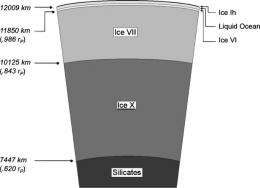Water Planets

Of the roughly 420 extra-solar planets now known, about a dozen are in the newly named category of "super-earths," planets whose masses are in between of two and about fifteen earth-masses.
So far it has not been possible to probe the interior structures of these objects directly, but scientists expect them to be one of three types: gas dominated (like Neptune), or rocky (like Mercury), or rich in water (more so than Earth).
Astronomers expect that new satellites designed to detect and characterize extrasolar planets will soon be able to provide clues to their interiors, especially from those super-earths whose atmospheres can be sampled because their orbits take them directly in front of and behind their star as seen from earth. To prepare for those results, scientists have begun modeling planetary interiors.
CfA astronomer Dimitar Sasselov, together with two of his colleagues, have begun the pioneering task of modeling the interiors of super-earths. They address in particular the class of objects rich in water. They define a "water planet" as any super-earth whose mass is more than 10% water, whose core is made of silicates or metals, and whose surface layer is lacking in significant amounts of gas. They model nine possible water planets with a range of masses and water contents (up to 50%), and study the near-surface layer for icy or ocean-like properties.
The astronomers find that the interiors of water planets have relatively well-defined zones, with characteristic densities and other properties that depend on the planets' masses, stellar heating, and other parameters. A water planet made of 50% water, for example, would have several layers thousands of kilometers thick, each of a different form of water-ice, with a thin outer crust made of yet other forms of ice, and a liquid ocean between crust layers. The results also help define an evolutionary time for the structures, which evolve distinctly over periods from a hundred thousand to a hundred million years. The study provides a realistic new basis for interpreting future observations of water planets.
Provided by Harvard-Smithsonian Center for Astrophysics

















